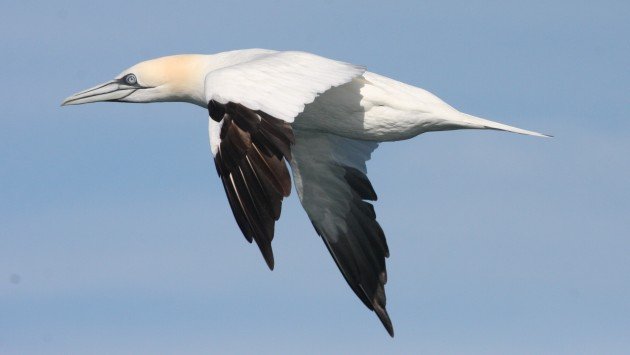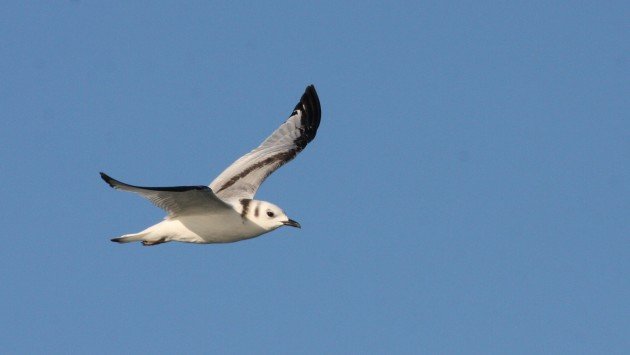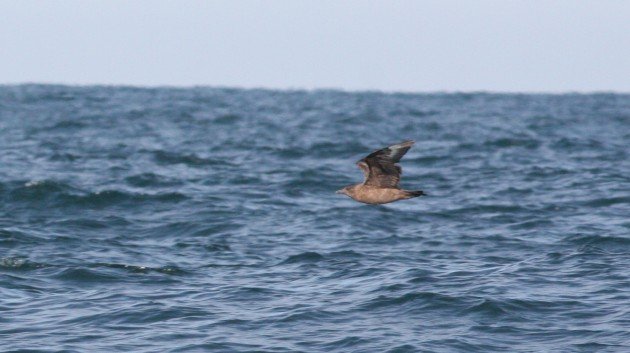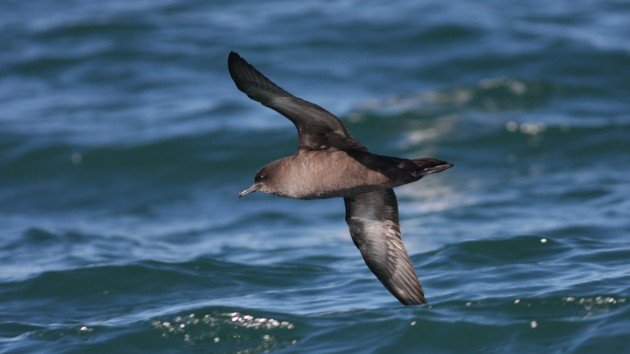
2013 was an excellent year for me as a birder. I reached two of my personal North Carolina birding goals this year. Of course, neither of them involved seeing Ruffed Grouse in the state, incidentally, which is a goal that still eludes me. Perhaps the most exciting was that I was finally asked to be a spotter on Brian Patteson’s Seabirding pelagic trips. It’s a dream come true. All the pelagic trips I could want and all I have to do is find birds, chat with people on board, and try not to throw up or fall asleep.
As you might imagine, I set my personal high for days offshore this year, and while there have been many highlights, like Long-tailed Jaeger and Trindade Petrel, the biggest highlight occurred at the end of the year when I happened to be on board Brian’s boat for Neil Hayward’s potential record-breaking Big Year bird. We were heading out to search for Great Skua, and nothing else would do.
I told myself several years ago that I was done taking winter pelagics. Once I finally saw Dovekie I hung up my rain suit and my long-johns and said no more would I freeze out on the ocean in the cold and wet. Not even the incredible record of a Black-browed Albatross in February of 2012 was enough to tempt me back. But when Neil said he had his eye on Hatteras, North Carolina, for his final push for the record, not even the promise of freezing in Brian’s new smaller boat, the Skua, was enough to keep me away. Due to a series of unlikely events I found myself on the dock at 6:00 am that fateful Saturday morning, camera and binoculars prepped for what I hoped would be a historic day.
We rolled out of the inlet and headed straight up north for Diamond Shoals, the heart of the Graveyard of the Atlantic itself. The shallow water there tends to attract a good number of gulls and gannets, and when gulls and gannets are fat and happy that’s when Skuas are most likely to show up.
Kate, expert chummer and ace birdspotter, had dragged in an impressive tail of gulls by the time we reached the shoals, and I was excited to see a young Black-legged Kittiwake join the party. These birds are small and delicate looking, but they’re no shrinking violets. The kittiwake, which was soon joined by an adult, dove into the chum scrums with gusto, duking it out with the much bigger but no less aggressive Herring and Great Black-backed Gulls. This was a state bird for me, so even if the skua hunt proved to be a failure, this trip offshore was going to be a success.
But admiring this little gull was selfish. We were out here for one thing and one thing only, to get Neil a Great Skua.
The strange thing about this particular trip was that we were in sight of land almost the entire day, which meant that I was never out of cell phone coverage. I was following along all morning with people’s well-wishes in the hunt and Ned Brinkley’s fantastic skua-finding tips. “Look below the horizon,” Ned would write, “the skua will cruise by and not even check out the boat. They’re easy to miss. Just keep scanning”.
I took his words to heart and scanned until I could scan no longer. Suddenly, while peering off the back of the boat, I noticed a big dark bird powering along with white-flashing wings. I panicked for a second. This was it. I squeaked out, “I got it!” And quickly, but without a ton of confidence, got Kate on the bird.
Here’s the thing about spotting on pelagic boats that makes it different that spotting birds on land. On land, you can usually hesitate, get your mind in order before you make that identifying cry. But on sea? You need to know it quick, because that bird is going to be gone in half a heartbeat. This has been the most difficult thing for me to get around. If you see something weird, call it out, because there’s no time for coulda beens.
Fortunately, Brian heard the hubbub and slammed the boat in reverse. The skua turned away from us, but came roaring back, barreling into the lazy gulls loafing on the water around us. It dipped and turned, chasing gulls and being chased itself. It gave us incredible views. Neil was happy. We were happy. And I don’t mind saying that it was really satisfying to be able to spot that bird.
Once the skua finally disappeared over the last horizon, a calm came over the boat. We’d done it. And everyone took a deep-breath and enjoyed the rest of the day. We’d seen our target and anything else was gravy.
Incidentally, that gravy mostly consisted of a Sooty Shearwater, a nice bird in the winter, that followed the boat for about a half hour as we cruised back inshore.
And you know, for all the worrying about the wind and the weather and the small boat, the day couldn’t have been nicer. The sun was out, the air was unseasonably warm, and the birds were plentiful, varied, and record-breaking.
I may just have to do a winter pelagic again one of these days.

















awesome